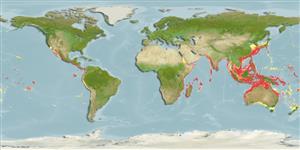Common names from other countries
Environment: milieu / climate zone / depth range / distribution range
Οικολογία
Υφαλόφιλο(α); εύρος βάθους 0 - 512 m (Ref. 106682). Tropical
Indo-Pacific. Tropical to subtropical.
Length at first maturity / Μέγεθος / Βάρος / Age
Maturity: Lm ? range ? - ? cm Max length : 60.0 cm WD αρσενικό/απροσδιόριστο; (Ref. 129602)
A large-sized starfish with seven to nine arms, eight being the most common. Aboral surface usually yellowish-brown, with four to six distinctive dark blotches on the arms. Central disc is very small, and long arms are tapered to a pointed end. Body surface is densely covered by abactinal paxillae, also having small sharp spines along the two sides of arms. Ambulacral groove is with two rows of tube feet that do not retract into the body.
Occurs on soft bottoms, exposed or buried in the sand (Also Ref. 129602) at depths of 0 to 90 m (Ref. 800). Also found on seagrass (Ref. 102259). Carnivorous and feeds on other echinoderms and molluscs (Ref. 800). Swallows prey as a whole, instead of protruding the stomach out to digest a prey (Ref. 125532).
Life cycle and mating behavior
Γεννητική Ωρίμανση | Αναπαραγωγή | Γεννοβολία | Αβγά | Γονιμότητα | Προνύμφες
Members of the class Asteroidea exhibit both asexual (regeneration and clonal) and sexual (gonochoric) means of reproduction. Life cycle: Embryos hatch into planktonic larvae and later metamorphose into pentamorous juveniles which develop into young sea stars with stubby arms.
Schoppe, S. 2000. (Ref. 800)
IUCN Red List Status (Ref. 130435)
CITES status (Ref. 108899)
Not Evaluated
Not Evaluated
Threat to humans
Harmless
Human uses
| FishSource |
Εργαλεία
Περισσότερες πληροφορίες
Age/SizeΑύξησηLength-weightLength-lengthΜορφολογίαΠρονύμφεςΑφθονία
Διαδικτυακές πηγές
Estimates based on models
Preferred temperature
(Ref.
115969): 24.2 - 29, mean 28 (based on 1518 cells).
Price category
Unknown.
